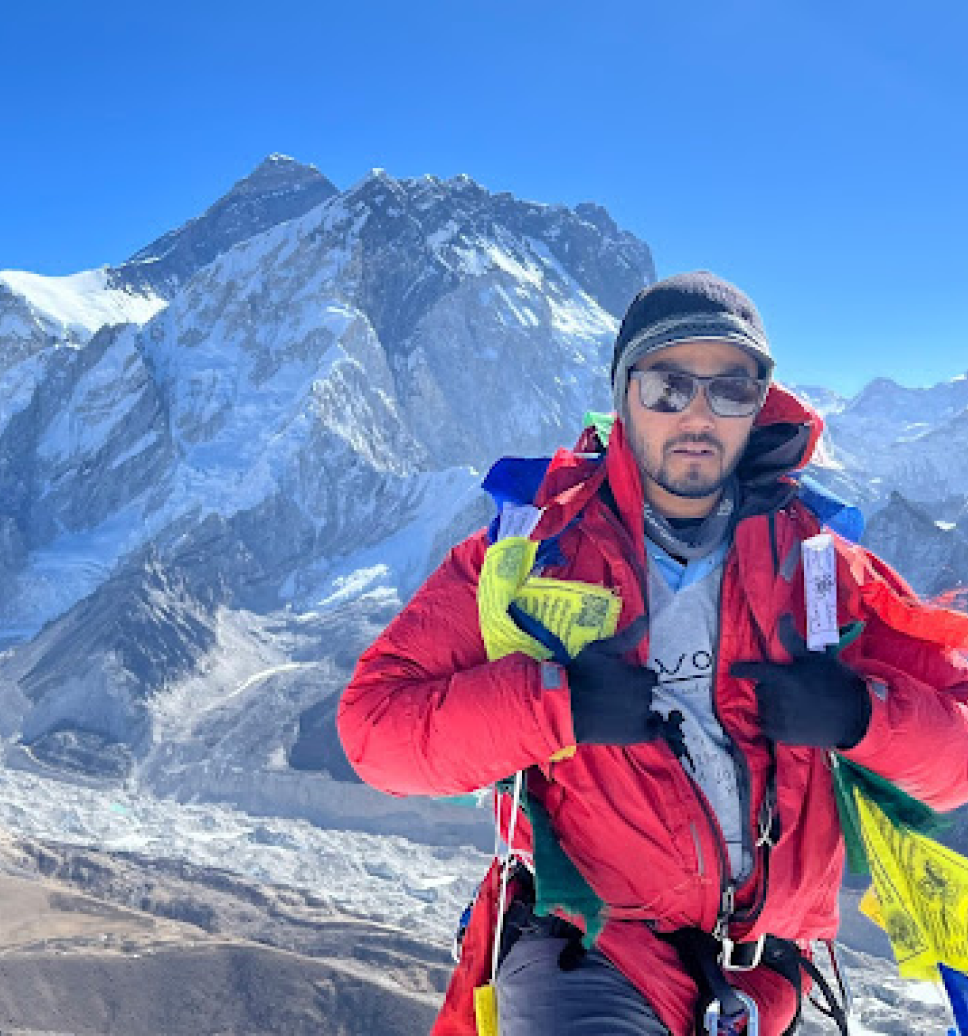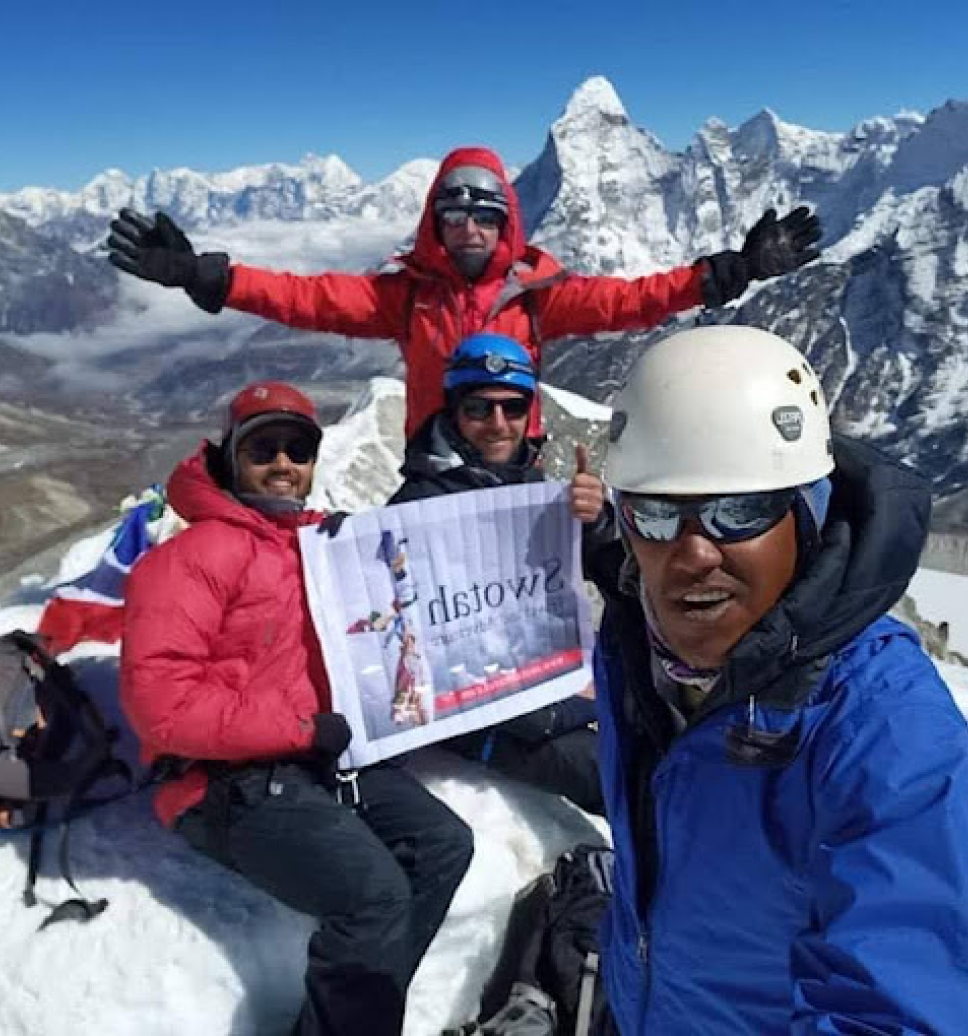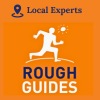GUARANTEED DEPARTURES
Check upcoming trip dates, availability & prices. If you can't see dates that suite you, contact us we will do our best to assist you.
| GUARANTEED DEPARTURES | PRICE | AVAILABILITY | |
| Mar 10, 2026 - Mar 27, 2026 | $2250 | High | |
| Apr 5, 2026 - Apr 22, 2026 | $2250 | High | |
| May 8, 2026 - May 25, 2026 | $2250 | High | |
| Sep 4, 2026 - Sep 21, 2026 | $2250 | High | |
| Oct 2, 2026 - Oct 19, 2026 | $2250 | High |
Trek Highlights
- Mera Peak has 3 distinct summits; North(6,476m), Central(6,461m), and South Mera Peak(6,064m).
- Mera Peak is considered one of the finest viewpoints in Nepal.
- Mera Peak stands to the south of Everest.
- J.O.M. Roberts and Sen Tenzing made the first successful ascent of Mera Peak on 20 May 1953.
- The major peaks observable from Mera peak include some of the highest mountains in the world; Mt. Everest, Cho-Oyu, Lhotse, Makalu, Kanchenjunga, Nuptse and many more.

Mera Peak is one of those peaks that perfectly blend adventure with culture. This week-long peak climbing is one of the most famous peaks among mountaineers. One of the reasons for its popularity is its accessibility to anyone with less or moderate experience in Mountaineering, which means a novice mountaineer can attempt to climb it with the proper guidance of Sherpas and Guides. The highest trekking peak in Nepal transports you through remote picturesque villages and lush forests, followed by a gentle climb to the summit. This trip packed with adventure, nature, and culture, is sure to give you an experience of a lifetime.
Tipping Recommendation
We recommend allocating 10-15% of your total tour cost to tipping guides, drivers, and other hardworking staff who ensure your experience is unforgettable. While tipping is not mandatory, it is a meaningful way to support the seasonal workers who dedicate themselves to making your trip extraordinary.
By booking with us and participating in the tipping culture, you are directly contributing to Nepal’s local economy and helping sustain the tourism workforce. This support is crucial in retaining talent within the country and addressing challenges like brain drain.
Your generosity makes a lasting impact—thank you!
Photo Gallery
Dive into our gallery to get a glimpse of the awe-inspiring vistas waiting for you on our guided treks across stunning landscapes.
Brief Itinerary
Comprehensive Trek Guide
Mera Peak, located in the Sagarmatha zone of Sankhuwasabha, is the highest trekking peak in Nepal, standing at an impressive 6476 m (21246.72ft). The trek to Mera Peak is known for its moderate difficulty level and low technical risk, making it accessible to most trekkers. From the summit of Mera Peak, one can enjoy breathtaking views of snow-covered mountains.
The journey to Mera Peak begins in Kathmandu, Nepal's capital city, and takes trekkers through small remote villages that offer a glimpse into the traditional Nepali lifestyle. Trekkers can explore dense forests and indulge in local dishes along the way.
The initial week of the trek is dedicated to absorbing Nepal's raw beauty, people, nature, cultural practices, monuments, stunning architecture, etc. The remaining days of the trek involve an expedition to Mera Peak and an exploration of the Khumbu region's Kothe, Kharka, and Lukla.
The trail leading up to Mera Peak offers a great deal of cultural and traditional diversity that trekkers can experience firsthand. Overall, the trek to Mera Peak is an excellent opportunity for adventure enthusiasts to immerse themselves in Nepal's natural beauty while exploring its rich culture and traditions.
Climb Difficulty
Mera Peak, at 6,476 meters, is an ideal climb for those seeking a challenging yet non-technical adventure. Despite the altitude, the route is not overly steep, however, it does require a long summit day, and you are exposed to the elements. It is important to stay hydrated and maintain a slow, manageable pace to prevent exhaustion. Additionally, it is important to note that the high altitude affects more than just your strength; it can also alter your appetite and sleep.
Novice mountaineers can join with proper guidance from Sherpas and Guides to climb the highest trekking peak in Nepal at 6,476 meters. Although not technically challenging, a long summit day and exposure to elements require a slow pace and proper hydration.
Accommodation on Mera Peak Climb
Regarding accommodation during the Mera Peak climb, trekkers typically stay in tea houses or lodges along the route. These tea houses offer basic accommodation, with small rooms equipped with a bed, blanket, and pillow. It's important to note that the rooms can get cold at night, so bringing a warm sleeping bag is highly recommended.
In terms of food, tea houses and lodges offer a variety of meals, including Nepalese and Sherpa cuisine. Breakfast usually consists of porridge, eggs, toast, and tea or coffee. For lunch and dinner, trekkers can enjoy dishes such as dal bhat (a lentil soup with rice and vegetables), noodles, pasta, and fried rice. Most tea houses also offer snacks such as chocolate bars and energy bars, which are great for refuelling during the climb.
At both Mera Peak base and High camp, you will be sleeping in mountain tents with two persons per tent. You should bring your 4-season sleeping bag and a high-quality sleeping mat. For lower altitudes, a sleeping bag liner can be used in conjunction with the sleeping bag, so that you do not get too warm. All necessary equipment can be easily rented if needed.
Best Time for Mera Peak Climbing
Mera Peak is best climbed during spring and autumn, offering stable weather conditions and clear skies for stunning views. However, summer and monsoon seasons should be avoided due to heavy rainfall, slippery trails, and fog.
Winter should also be avoided due to short days and extremely cold temperatures. Flight tickets and accommodation should be booked in advance during peak season, as the trail may get crowded.
Required Permits
To climb Mera Peak, it is essential to acquire a climbing permit from the Nepal Mountaineering Association (NMA) and a trekking permit from the Nepal Tourism Board office located at Bhirkutimandap in Kathmandu. The climbing permit cost varies depending on the season, ranging from USD 70 to 250, while the National Park Permit costs USD 15 for SAARC nationals and USD 30 for other nationals. These permits can only be obtained through a government-registered trekking agency.
With Swotah travel, you can get your climbing and trekking permits in just a few steps. You must provide us with a photograph, a copy of your passport, and a copy of your travel insurance policy. We will then provide you with the necessary forms to be filled out and submitted to the appropriate authorities, along with the necessary payment. Once the paperwork is complete, we will collect your permits and provide you with a copy to carry with you on the trek.
We understand the importance of getting the necessary permits and the process's complexities. We strive to make this process as efficient as possible so that you can focus on what truly matters - enjoying your trek to Mera Peak.
Training for Mera Peak Climbing
Preparing for a Mera Peak climb requires physical and mental training. Novice mountaineers should start with regular cardio exercises like running, hiking, or cycling to build endurance. Strength training, especially for the legs and core muscles, is also crucial as it helps distribute weight evenly during the trek.
In addition to physical fitness, climbers must acclimate themselves to high-altitude conditions. This can be done by gradually increasing elevation gain during training hikes and spending time at higher altitudes before the climb.
Mental preparation is also essential as climbing a peak like Mera requires determination, perseverance, and mental fortitude. Maintaining a positive mindset and preparing for the challenges that may arise during the climb is important.
What's Included
- All airport transfers are in a private vehicle.
- Climbing permit for Mera Peak.
- First Aid medical kits for the Group and the staff.
- Standard/Deluxe rooms in Kathmandu on a B/B basis
- Required fixed and dynamic rope during the climbing period.
- Local English-speaking Guide for Sightseeing in Kathmandu
- All wages, equipment, medical and accidental Insurance for all involved staff.
- Flight Tickets for the Kathmandu-Lukla-Kathmandu sector to all climbing members and Staff.
- All necessary paperwork, office Service charges, and Government Taxes levied in Nepal.
- Necessary staff, including experienced guides and porters(3:1), during the trekking and climbing.
- Required Experienced, Trained and Government Licensed Climbing Guide(s) during the Climbing Period as per the size of the group.
- Full-day sightseeing in Kathmandu.
- Per person, 20 kg baggage allowance during trekking-up carrying by porter or Yak and 20 kg baggage allowance while returning from Base Camp after climbing the peak.
- Trekking Permit (National Park entry fee) and TIMS card (Trekking Information Management System).
- All trekking and camping equipment like camp furniture, kitchenware, dining tents, guest tents, etc.
- Appropriate food for high altitude and all climbing crew at base camp and above as required.
- Complete pre-departure information, flight ticket reconfirmation, and visa extension procedure services (if necessary).
- 3 meals a day (Breakfasts, Lunch, and Dinners with tea or coffee) along with available accommodation at a Hotel/Lodge/Guest Houses or tents for members and staff during the trek and climbing on a twin-sharing basis. Sightseeing/Monument entrance fees in Kathmandu.
What's not Included
- Lunch in Kathmandu
- Emergency rescue evacuation if required
- Personal accident insurance or Helicopter rescue (it will be covered by the insurance company)
- International flights
- Nepal entry visa; you can obtain a visa easily upon your arrival at Tribhuvan International Airport in Kathmandu. (A Tourist Visa with Multiple Entries for 30 days can be obtained by paying US $ 40 or equivalent foreign currency. Similarly, a Tourist Visa with Multiple Entries for 90 days can be obtained by paying US $ 100. Please bring 2 copies of passport-size photos)
- Any kind of hot and cold drinks, a hot shower
- Alcoholic beverages, Mineral water, laundry, phone calls, internet
- Personal climbing equipment
- All kinds of Personal Expenses
- Icefall fees and Garbage Deposit fees (Shared with another member), if applicable
- Wake talkies &Filming permit
- Any other expenses which are not mentioned in the 'Price Includes' section
- Personal climbing guide if requested
- Optional trips and sightseeing if extended
- Tips for guides and porters
- Excess baggage charges (if you have more than 15 kg of luggage, a cargo charge is around $1.5 per kg)
Frequently Asked Question
1.What are the physical requirements for this trip
2.Will your company representative come to receive us upon arrival at the airport
3.What type of accommodation will you use at Kathmandu and during the trek
4.How will my booking be processed
5.How can I pay the remaining payment after arriving at the Kathmandu
6.What type of food can I get during the trek and is it healthy
7.Is safe drinking water available while climbing
8.What type of transportation do you use
9.What is the best season for the trekking
10.How can be the weather and the temperature like in the trekking
11.How far do I trek each day
12.Do your trekking guides have licenses and certificates in the tourism sector and Have they received first aid training for the high altitude
13.What safety measures can your guides do during the emergency like high altitude sickness, accidents and dehydration
14.Are climbing guides well trained and have they already climbed this summit before
15.Do we need to book our own international flights to and from the Nepal
16.During the trek, can we charge the camera and other equipment
17.Is there any communication system during the trek
18.Can I use credit card during this trip
19.How much additional money do I need to carry with me during the trek
20.Can I add extra days to my trekking trip
21.Do you prefer yak or porter on the trek or should we need to carry by ourselves
22.Can we store our clothes which are not necessary for the trek
23.What is the temperature rating of the sleeping bag that you lend of trekkers
24.How should I dress during the trek
25.Is it possible to change the lodge if it is not in order
26.Do you reserve rooms at the lodges before or during the trek
27.What immunization will I need
28.Do we need to carry our bags by our self or you will provide porters
29.What about security during trekking
30. will there be a problem for vegetarians
Company Reviews
Similar Trips
Related Trips
Let your travels tell a story—crafted by locals, inspired by mountains, and lived by you.




















